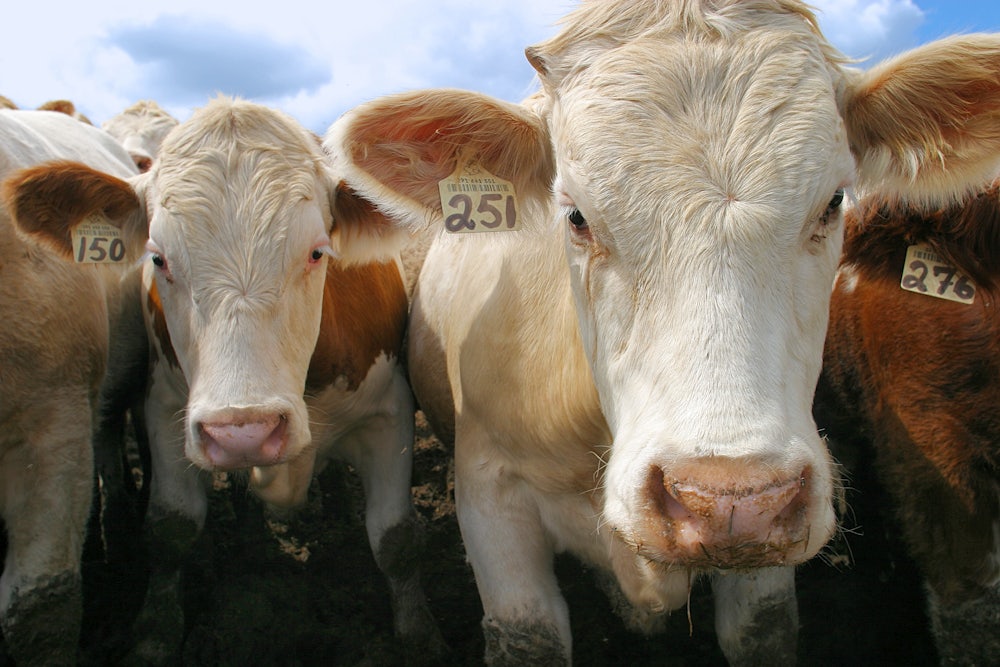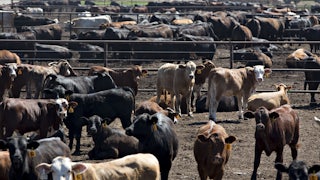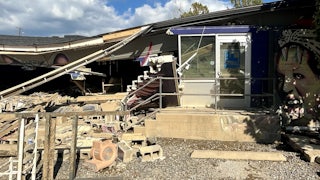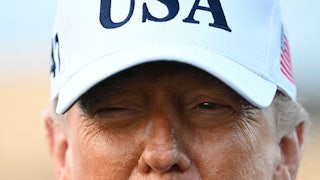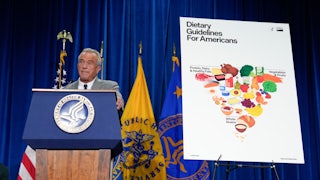Upton Sinclair, author of the scathing 1906 meat industry exposé The Jungle, would later in his life coin a particularly useful aphorism: “It is difficult to get a man to understand something when his salary depends on his not understanding it.” But if you’ve been following news about the meat and dairy industries this fall, that aphorism might well be rearranged to this: It is difficult to get a man to understand something when his tastes depend on not understanding it.
At a time when the corpses of dairy cattle felled by the H5N1 avian flu are left to rot on roadsides in California’s Central Valley and human cases of the disease creep upward, and when water-guzzling feed crops for beef and dairy are driving the American West’s worsening water crisis, the biggest stories about livestock in the national media in the past few months were downright effusive about the industry’s future: With a few small fixes to their diets, these stories promised, cows can transform from climate villains to climate heroes, ushering in an era of net-zero beef and dairy. This blend of science, public relations, and status quo bias might be the best window yet into the meat industry’s quest to prevent any serious discussion about the environmental and public health problems posed by animal agriculture.
The recent positive press about cows revolves around a red algae seaweed native to Australia called Asparagopsis taxiformis. Over the past half-decade, a number of studies have been published showing that, under small-scale and short-term experimental conditions, adding dried and processed asparagopsis to cows’ feed on feedlots and dairy farms can massively diminish the amount of methane they belch into the atmosphere. Two of the most widely cited studies report reductions of up to 80 percent and up to a stunning 98 percent. The news media has dutifully covered these studies, usually taking them at face value. The Guardian alone has run stories about the promise of feed additives in 2021, 2023, and this past August; since then asparagopsis has also been covered by The Wall Street Journal and on NBC. (I was a guest on the NBC segment, where I presented a very short version of the argument in this article.)
If feeding cows seaweed really did reduce their total emissions by 98 percent, and if asparagopsis production and distribution could be scaled globally, this sort of reduction would be a game-changer. But it’s not clear that the math actually holds up. Feed additives are only really effective mixed into processed feed, meaning they work best in industrialized systems where ruminants are confined and fed a prepared diet rather than when they’re grazing on pasture. Most beef cattle are slaughtered between 18 and 24 months of age and spend the majority of their lives on pasture, only being rounded up on feedlots for the last few months of their lives and fed corn, soy, and grasses like alfalfa. This feed is designed to fatten cattle to slaughter weight, but it’s also much easier to digest, meaning that most beef cattle will only emit about 11 percent of their lifetime emissions on feedlots. Dairy cows, meanwhile, live longer than beef cattle and are kept in barns for most of their lives, where they are inseminated, separated from their young, and milked for their productive lives. This means dairy cattle eat an almost all-feed diet, but it also means they emit relatively less over their lifetime than beef cattle because they’re not digesting roughage.
Back in 2021, seeing the discrepancy between the reduction promised by headlines and press releases and the basic facts of cows’ life cycles, New York University environmental science professor Matthew Hayek and I did some back-of-the-envelope calculations and came up with far less promising numbers. Assuming an 80 percent reduction of emissions on feedlots, where cattle emit 11 percent of their methane, we figured that would make asparagopsis lead to lifetime emissions reductions of about 9 percent. Even that bombastic 98 percent reduction estimate—which hasn’t been replicated in any other studies—would still only result in about an 11 percent total emissions reduction. Hardly game-changing numbers.
Since then, longer-term trials have showed our calculations were, if anything, too optimistic. A 300-day study of Wagyu cattle on a feedlot in Australia—Wagyu are allowed to live longer than standard American Angus cattle and spend longer on feedlots to develop the fatty tissues for which their carcasses are so prized—showed only a 28 percent reduction in methane over those 300 days. If we again assume that only 11 percent of the Wagyu’s lifetime emissions take place on feedlots, that means algae additives would reduce only 28 percent of 11 percent of lifetime emissions, amounting to a 3 percent total reduction. But even if we assume that Wagyu emit more of their lifetime emissions on feedlots instead—say, a third of their total emissions—a 28 percent reduction of one-third of lifetime emissions still comes out to around 9 percent: pretty much exactly what Hayek and I calculated. Either way, the math throws cold water on the hype.
Feeding algae to beef cattle, in short, doesn’t do much. So algae proponents have switched to touting the possible benefits of feeding algae to dairy cattle instead. Here, the numbers from long-term trials are a little more optimistic but still fall far short of upending agriculture as we know it: a 25 percent lifetime reduction in a Norwegian study and 38 percent in an Australian one. However, the Norwegian study noted that dairy cattle fed asparagopsis had lower milk yield and high milk iodine content, leading its authors to question the viability of large-scale asparagopsis use. If feeding cows algae reduces the quality or quantity of the goods they produce, this plan might not make practical or economic sense.
This math may seem tedious. But ultimately, claims about emissions reductions are claims about math. So the best way to evaluate these claims is by asking three questions.
First, does the math add up? That’s what I’ve explained above: In this case, it doesn’t.
Second, can the solution be scaled such that the math can apply globally and really make a dent in total emissions? Scholars have been asking questions about the feasibility of large-scale asparagopsis use ever since studies about it started being published, and the answer to these questions is far from clear. Asparagopsis is a tropical seaweed that acts as an invasive species if it spreads to new habitats, meaning that growing it in marine environments would be tricky. It lends itself best to on-land aquaculture cultivation, but the economics of scaling this technology and getting the seaweed to any meaningful fraction of the planet’s billion-plus cows would be a herculean undertaking.
Another problem with scaling up would involve dose control: The reason that asparagopsis reduces cows’ methane is because it contains bromoform, which is toxic to humans and currently classified by the Environmental Protection Agency as a “probable human carcinogen.” Initial research suggests the risk to humans is pretty low if the initial dose to the cow is low. But that does mean doses given to cows would have to be low enough that this didn’t find its way into their milk.
Third, how does the reduced-emissions product compare to alternatives? For beef and dairy coming out of the asparagopsis trials, the answer is: terribly. Reducing beef emissions by 3 percent, or even 9 percent, would still leave beef at least five times as greenhouse gas–intensive as other meats, and even more so than plant-based proteins like beans, tofu, or Impossible burgers. And even 38 percent-less-emitting dairy emits more greenhouse gas than soy milk. So even if asparagopsis could be scaled, beef and dairy would still be the most climate-unfriendly foods available. This shouldn’t be surprising given the physical qualities of ruminants, which simply can’t be erased with a sprinkle of fairy—sorry, seaweed—dust. It’s the cow, not the how, as it were.
Given all this, there’s a real risk that focusing on algae and other feed additives will distract from true food-systems emissions reduction and, instead, help “greenwash” the animal agriculture industry—making it seem more environmentally friendly than it actually is. That may already be happening.
Since at least 2006, when the United Nations Food and Agriculture Organization published the “Livestock’s Long Shadow” report showing the magnitude of the global livestock industry’s environmental and climate impact, that industry has divided its time between trying to discredit the science and scientists linking its emissions to climate change and promising that it can reduce those very emissions. As academic, government, and public scrutiny of the climate impacts of food have only increased, the animal agriculture industry has responded by making broad and often unsubstantiated promises about lower-emissions products or even about becoming net-zero.
It’s the clean coal debacle all over again. For instance, Tyson Foods has been marketing its Brazen Beef brand as more climate friendly. Matthew Hayek and I broke down the dubious math of those claims for The New Republic last year. Now Tyson is being sued for false advertising of Brazen by the Environmental Working Group. This comes on the heels of JBS, the Brazil-based meat giant, being sued in New York state for false advertising over making unsubstantiated claims about its ability to reach net-zero.
Greenwashing matters not simply because it’s often based on spurious claims but because it aims to stave off regulation by showing policymakers that polluters are being proactive in lowering their carbon footprints. Greenwashing also serves, as the New York state suit against JBS argues, to “provide environmentally conscious consumers with a ‘license’ to eat beef.”
In others words, as environmental science increasingly points to the need to drastically reduce the amount of beef and dairy in our diets, the promise that beef and dairy can instead be made greener might stop consumers or institutions concerned with climate change from changing what food they choose to buy. Greenwashing eases or erases the concerns that might spur change. And people want their concerns to be eased. This is what makes the story of asparagopsis so appealing: The public is hungry for anything but change.
This impulse quickly becomes self-rationalizing. For example, some argue that humans will keep eating meat and drinking dairy, so we should at least try to make them more sustainable. This feels like basic common sense. But behind it lurks the very complacency that greenwashing is designed to fuel: the assumption that change is unnecessary, undesirable, and perhaps even impossible.
All of the talk about seaweed—including all of this article so far—falls victim to a much bigger issue: a carbon tunnel vision that reduces environmental impacts and sustainability measurements only to emissions. Merely reducing emissions from beef and dairy—no matter how much—does nothing to offset its other impacts on soil and water, on labor, on the animals themselves, or on public health. And it doesn’t address one of the biggest ways beef and dairy exacerbate both emissions and other forms of environmental degradation: by driving deforestation, as wilderness is replaced with grazing lands and crops grown for animal feed. We not only need more laws and lawsuits cracking down on corporate greenwashing, but we need changes in agricultural policy, diets, and technology that will allow us to shift our food system away from livestock toward more sustainable alternatives.
Seaweed, then, doesn’t just fail to reduce emissions as well as promised. It sucks the air out of productive debate. Hoping for any simple solution to hack complex food system problems distracts us from both the complexity and the magnitude of the changes necessary. Red algae, in other words, is a red herring.
